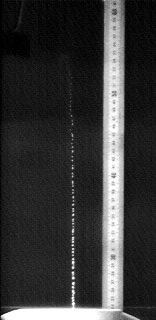Granular Flows - Current Interests

- Impacts in granular systems: We have been investigating impact craters formed by dropping a projectile into a bed of granular material. We study the dynamics of the crater formation process with high-speed video flow visualization techniques, and the morphology of the crater that remains at the end by using a laser profilometer to scan the shape of the crater. Our initial motivation for this work was as a model for meteor impacts, but we now believe that the energetics is very different in the granular case – in a large meteor impact, almost all of the kinetic energy of the meteor is used to excavate the crater against gravity, whereas in our granular experiments, the excavation energy is only a fraction of a percent of the total impact energy. These experiments can tell us about the way in which forces are transmitted through granular materials, and about the nature of friction and dissipation in granular flows.
- Collapse of a granular cavity: We are also studying the formation of craters by a simpler process – the collapse of a cavity formed in a granular system. An object inserted into a granular bed is removed very quickly, leaving a hole. The walls of the hole collapse, and at the end of the process we again have a crater. We have studied this process in a fully three-dimensional system and in a thin, quasi-two-dimensional system. In the 2D case, we can look at the granular flow below the surface by tracking the motion of the grains using high-speed video and PIV software.
- Modeling of granular flow: We have made use of simple continuum models to study cavity collapse in two- and three-dimensional granular systems. Comparison of the model results with our experiments suggests that although the model gets the collapse process qualitatively correct, it does not account for dissipation in the granular flow very well. We want to explore this more fully using more complex – and more physical – models.



